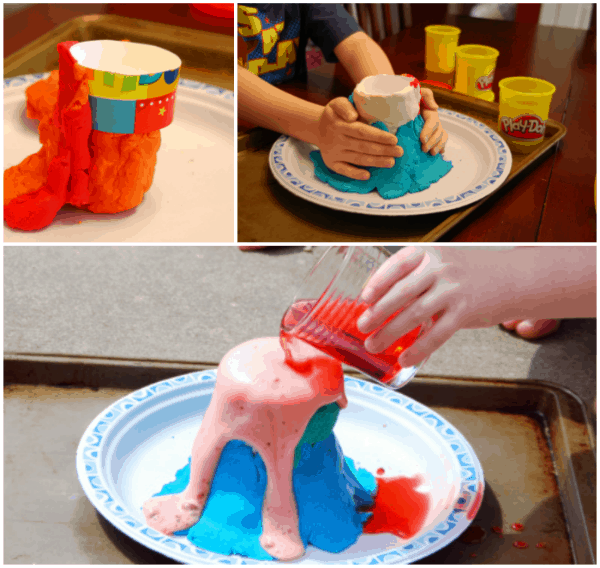Science can be incredibly fun and educational, especially when kids can engage in hands-on experiments using everyday household items. These activities not only spark curiosity but also teach basic scientific concepts in an interactive way. Here are 10 exciting science experiments that kids can safely perform at home with minimal supervision.
1. Baking Soda and Vinegar Volcano
Materials Needed: Baking soda, vinegar, dish soap, food coloring, a small plastic bottle, and a tray or bowl.
Steps:
- Place the plastic bottle on the tray.
- Add 2 tablespoons of baking soda, a few drops of dish soap, and food coloring into the bottle.
- Pour in vinegar and watch the “lava” erupt!
Science Behind It: The chemical reaction between baking soda (a base) and vinegar (an acid) releases carbon dioxide gas, creating the bubbly eruption.
2. Rainbow Milk Experiment
Materials Needed: Whole milk, dish soap, food coloring, and a shallow dish.
Steps:
- Pour milk into the shallow dish to cover the bottom.
- Add a few drops of different food coloring around the dish.
- Dip a cotton swab in dish soap and touch it to the milk.
- Watch the colors swirl like magic!
Science Behind It: The dish soap breaks down the fat molecules in the milk, causing the colors to move and mix.
3. Homemade Lava Lamp
Materials Needed: A clear glass or bottle, vegetable oil, water, food coloring, and an effervescent tablet (e.g., Alka-Seltzer).
Steps:
- Fill the glass three-quarters full with oil and add water until almost full.
- Add a few drops of food coloring.
- Drop in the effervescent tablet and watch the colorful bubbles rise and fall.
Science Behind It: The reaction releases gas, creating bubbles that carry colored water through the oil.
4. Static Electricity Balloon
Materials Needed: Balloons and small pieces of paper.
Steps:
- Inflate a balloon and tie it.
- Rub the balloon on your hair or a wool cloth to generate static electricity.
- Hold the balloon near the paper pieces and watch them stick.
Science Behind It: Rubbing the balloon transfers electrons, creating static electricity that attracts the paper.
5. Egg in a Bottle
Materials Needed: A peeled hard-boiled egg, a glass bottle with a narrow neck, and matches.
Steps:
- Light a match and drop it into the bottle.
- Quickly place the egg on the neck of the bottle.
- Watch as the egg gets sucked into the bottle.
Science Behind It: The burning match heats the air, which then cools and creates a vacuum, pulling the egg inside.
6. DIY Slime
Materials Needed: White glue, water, food coloring, and borax (or liquid starch).
Steps:
- Mix equal parts glue and water in a bowl.
- Add food coloring.
- In another cup, dissolve a teaspoon of borax in water and slowly mix it into the glue solution.
- Knead until it turns into slime.
Science Behind It: The borax links the glue molecules together, forming a stretchy polymer.
7. Floating Egg Experiment
Materials Needed: A raw egg, water, and salt.
Steps:
- Fill a glass with water and place the egg inside (it will sink).
- Gradually add salt to the water and stir until the egg floats.
Science Behind It: Salt increases the water’s density, making it buoyant enough to support the egg.
8. Color-Changing Cabbage
Materials Needed: Red cabbage, hot water, vinegar, baking soda, and clear cups.
Steps:
- Chop the cabbage and soak it in hot water to extract the purple juice.
- Pour the juice into cups and add vinegar to one and baking soda to another.
- Observe the color changes.
Science Behind It: Red cabbage juice acts as a pH indicator, changing color in the presence of acids or bases.
9. Growing a Bean in a Jar
Materials Needed: A clear jar, a paper towel, water, and a dry bean.
Steps:
- Wet the paper towel and line the inside of the jar.
- Place the bean between the paper towel and the jar wall.
- Keep the towel moist and watch the bean sprout over days.
Science Behind It: The moisture activates the bean, triggering germination.
10. Homemade Rainbow
Materials Needed: A glass of water, a flashlight, and a piece of white paper.
Steps:
- Place the glass of water near a light source.
- Shine the flashlight through the glass onto the paper.
- A rainbow will appear on the paper.
Science Behind It: The water refracts and disperses light into its component colors, creating a rainbow.
Conclusion
These simple experiments provide a fun way for kids to explore scientific principles right at home. They encourage curiosity, creativity, and a hands-on understanding of the world around them. With just a few household items, kids can embark on an exciting journey of discovery and learning.

